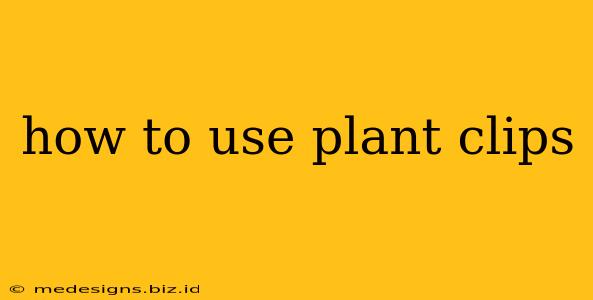Plant clips, those humble yet incredibly useful gardening tools, are essential for supporting climbing plants, training unruly branches, and securing delicate stems. Whether you're a seasoned gardener or just starting out, mastering the art of using plant clips can significantly enhance the health and aesthetic appeal of your plants. This guide will walk you through everything you need to know, from choosing the right clips to proper application techniques.
Choosing the Right Plant Clips
The market offers a variety of plant clips, each designed for specific purposes. Understanding these differences is key to successful plant support.
Types of Plant Clips:
-
Plastic Clips: These are readily available, inexpensive, and suitable for a wide range of plants. They come in various sizes and are generally reusable. Look for clips made from durable, weather-resistant plastic.
-
Metal Clips: Metal clips, often made from coated wire or spring steel, are more robust and ideal for heavier plants or those requiring stronger support. They can last for many seasons but might be more expensive.
-
Adjustable Clips: These versatile clips allow you to adjust the clamping force, making them suitable for plants of different thicknesses.
-
Specialized Clips: Some clips are designed for specific tasks, such as tomato clips that have a unique shape to support the weight of tomatoes.
Factors to Consider When Choosing:
-
Plant Size and Weight: Consider the size and weight of your plants when selecting clips. Larger, heavier plants require stronger, more durable clips.
-
Plant Type: Different plants have different support needs. Delicate plants might require gentler clips than sturdy, woody vines.
-
Clip Material: Consider the durability and weather resistance of the clip material. Plastic clips are generally suitable for most applications, while metal clips are more durable but can be more expensive.
How to Use Plant Clips Effectively
Properly using plant clips is crucial for preventing damage to your plants. Here's a step-by-step guide:
Step-by-Step Instructions:
-
Assess Your Plant's Needs: Before attaching any clips, carefully examine your plant to identify areas requiring support. Look for stems that are bending or falling over, or branches that need to be trained in a specific direction.
-
Choose the Right Clip: Select a clip that's appropriate for the size and weight of your plant and the specific support needed.
-
Gentle Placement: Gently position the clip around the stem or branch you want to support. Avoid applying excessive pressure, which could damage the plant.
-
Secure the Clip: Secure the clip firmly, ensuring it's positioned correctly to provide adequate support without constricting the plant's growth.
-
Support Structure: For climbing plants, consider using a trellis, stake, or other support structure in conjunction with the clips.
-
Regular Inspection: Regularly inspect your plants and clips to ensure they are still providing adequate support and haven't become loose or damaged. Adjust or replace clips as needed.
Tips for Using Plant Clips
-
Avoid Over-Tightening: Over-tightening clips can damage the plant stem. Ensure the clip provides support without constricting the plant's growth.
-
Proper Spacing: Space clips evenly along the stem or branch to distribute weight evenly.
-
Regular Maintenance: Regularly inspect your plants and clips for damage or loosening.
-
Seasonal Considerations: Remove or replace clips as needed throughout the growing season. You might need to adjust your support system as plants grow.
Troubleshooting Common Plant Clip Issues
-
Clips are too tight: Loosen the clips slightly to prevent stem damage.
-
Plants are growing out of clips: Add more clips or consider a different support system.
-
Clips are breaking: Replace the clips with stronger, more durable ones.
By following these tips and guidelines, you can effectively use plant clips to support your plants and help them thrive. Remember, proper use of plant clips will contribute to healthier, more beautiful plants in your garden!
